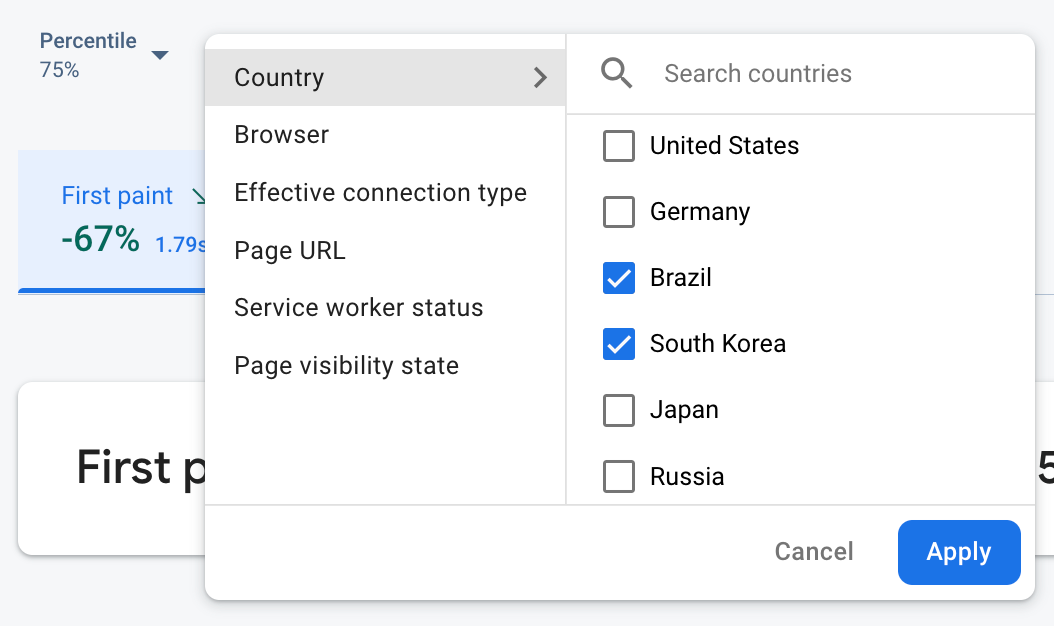Performance Monitoring umożliwia segmentowanie danych o skuteczności za pomocą atrybutów i skupianie się na skuteczności aplikacji w różnych rzeczywistych scenariuszach.
Po kliknięciu nazwy śladu w tabeli śladów (u dołu panelu Wydajność) możesz przejść do szczegółowych danych, które Cię interesują. Użyj przycisku
 Dane monitorowania wydajności Firebase filtrowane według atrybutu" />
Dane monitorowania wydajności Firebase filtrowane według atrybutu" />
- Filtruj według adresu URL strony, aby wyświetlić dane dotyczące konkretnej strony witryny.
- Filtruj według użytego rodzaju połączenia, aby dowiedzieć się, jak połączenie 3G wpływa na Twoją aplikację.
- Filtruj według kraju, aby sprawdzić, czy lokalizacja bazy danych nie wpływa na określony region.
Atrybuty domyślne
Performance Monitoring automatycznie zbiera różne atrybuty domyślne w zależności od typu śladu.
Oprócz tych atrybutów domyślnych możesz też tworzyć atrybuty niestandardowe w niestandardowych śladach kodu, aby segmentować dane według kategorii specyficznych dla Twojej aplikacji. Na przykład w grze możesz segmentować dane według poziomu gry.
Domyślne atrybuty zbierane w przypadku aplikacji internetowych
Wszystkie ślady w przypadku aplikacji internetowych domyślnie zbierają te atrybuty:
- Przeglądarka
- Kraj
- Użyty rodzaj połączenia
- URL strony
- Stan skryptu service worker
- Stan widoczności
zbierać dane użytkowników,
Tworzenie atrybutów niestandardowych
Możesz tworzyć atrybuty niestandardowe w dowolnych logach czasu z niestandardowego kodu, w których zastosowano instrumentację.
Użyj Performance Monitoring Trace API, aby dodać atrybuty niestandardowe do logów czasu niestandardowego kodu.
Aby używać atrybutów niestandardowych, dodaj do aplikacji kod, który definiuje atrybut i wiąże go z określonym śladem kodu niestandardowego. Atrybut niestandardowy możesz ustawić w dowolnym momencie od rozpoczęcia do zakończenia śledzenia.
Pamiętaj:
Nazwy atrybutów niestandardowych muszą spełniać te wymagania:
- Brak spacji na początku i na końcu, brak znaku podkreślenia (
_) na początku. - Brak pokoi
- Maksymalna długość to 32 znaki.
- Dozwolone znaki w nazwie to
A-Z,a-zi_.
- Brak spacji na początku i na końcu, brak znaku podkreślenia (
Każdy ślad kodu niestandardowego może rejestrować maksymalnie 5 atrybutów niestandardowych.
Upewnij się, że atrybuty niestandardowe nie zawierają żadnych informacji, które umożliwiają Google identyfikację konkretnej osoby.
Więcej informacji o tych wytycznych
Web
import { trace } from "firebase/performance"; const t = trace(perf, "test_trace"); t.putAttribute("experiment", "A"); // Update scenario t.putAttribute("experiment", "B"); // Reading scenario const experimentValue = t.getAttribute("experiment"); // Delete scenario t.removeAttribute("experiment"); // Read attributes const traceAttributes = t.getAttributes();
Web
const trace = perf.trace("test_trace"); trace.putAttribute("experiment", "A"); // Update scenario trace.putAttribute("experiment", "B"); // Reading scenario const experimentValue = trace.getAttribute("experiment"); // Delete scenario trace.removeAttribute("experiment"); // Read attributes const traceAttributes = trace.getAttributes();

